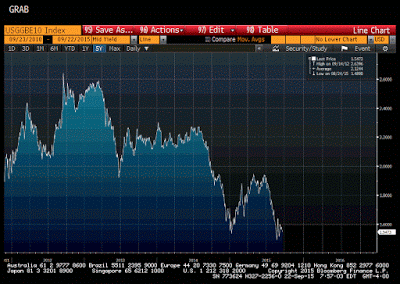The Federal Reserve threw investors a curve ball last week. Until then, Fed officials have shown a clear preference for survey-based measures of inflation expectations. Last week, seemingly out of the blue that Fed made reference to market-based measures of inflation expectations. It implied that the decline in the break-evens (difference between conventional and inflation-linked bond yields) got officials’ attention.

This is what we mean by temporal inconsistencies, and why anticipating what the Fed will do is so difficult. There are two basic ways to measure inflation expectations, surveys and market-based. The Fed showed a preference for one and then cited the other.
This Great Graphic, created on Bloomberg, of the 10-year break-even over the last several years. There was a big down move in the second half of last year, which corresponded to the sharp drop in oil prices. The 10-year break-even took another leg down in July and August, which again coincided with another drop in oil prices.

The accuracy of the break-evens and market-based measures, in general, at forecasting future inflation needs to be asked. Not coincidentally, within two business days of the FOMC decision, two economists at the San Francisco Fed issued a brief note answering the question.
The short answer is that market-based measures are the poorest predictors of future inflation. The San Fran Fed’s economists compare market-based measures (break evens and inflation swap rates) with surveys of professionals (the Fed conducts a Survey of Professional Forecasters and the Blue Chip Financial Forecasts) and methods including an unchanged forecast and a forecast that assumes the Fed inflation target is reached. In many ways, the results are not surprising. They confirm the findings of a body of economic research that finds market-based measures of inflation expectations are not particularly accurate, and that superior methods are readily available.












Leave A Comment